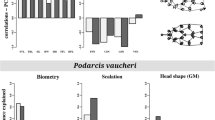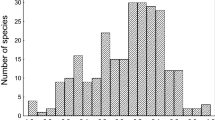Abstract
The process of species formation is often ignored in discussions on the conservation of biodiversity. Yet the clearance of vegetation may promote divergence among populations of a species through isolation, providing conditions for rapid genetic drift and novel selection pressures. Here, stepwise discriminant function analysis and fluctuating asymmetry are used to examine variation in morphology within and among non fragmented and recently fragmented populations of two species of gecko,Oedura reticulata andGehyra variegata. High reclassification error rates using discriminant function analysis, indicate that fragmentation has had no detectable effect on morphological differentiation among populations of either species. In contrast, remnant populations of both species exhibit higher mean levels of fluctuating asymmetry than do populations in undisturbed habitat. ForOedura reticulata, levels of fluctuating asymmetry are negatively correlated with the log of adult population size. These results suggest that the changes following habitat clearance have been severe enough to cause increased developmental instability in populations of both species but not detectable morphological divergence. Given the high rate of extirpation of gecko populations in the study region and the extreme vulnerability of the remaining populations, it is unlikely that species formation will be significant in maintaining reptile diversity in that region.
Similar content being viewed by others
References
Arnold, G. W. and J. R. Weeldenburg (1991)The distributions and characteristics of remnant native vegetation in parts of the Kellerberrin, Tammin, Trayning and Wyalkatchem Shires of Western Australia. PO Box 84 Lyneham, ACT 2602.
Balon, E. K. (1993) Dynamics of biodiversity and mechanisms of change: a plea for balanced attention to form creation and extinction.Biological Conservation 66: 5–16.
Brown, L. R., P. B. Moyle, W. A. Bennett and B. D. Quelvog (1992) Implications of morphological variation among populations of California roachLavinia symmetricus (Cyprinidae) for conservation policy.Biological Conservation 62: 1–10.
Bustard, H. R. (1968) The ecology of the Australian gecko,Gehyra variegata, in northern New South Wales.Journal of Zoology, London 154: 113–138.
Clarke, G. M. and J. A. McKenzie (1987) Developmental stability of insecticide resistant phenotypes in blowfly; a result of canalizing natural selection.Nature 325: 345–346.
Case, T. J. (1982) Ecology and evolution of the insular gigantic Chuckawallas,Sauromalus hispidus andSauromalus varius. pp. 182–212.In G. M. Burghardt and A. S. Rand (eds.)Iguanas of the world. Noyes Publ., Park Ridge, New Jersey.
Chapman, A. and J. Dell (1980) Reptiles and frogs of Yorkrakine Rock, East Yorkrakine and North Bungulla nature reserves.Biological survey of the Western Australian wheatbelt. Part 11. Records of the Western Australian Museum 12 (Supplement): 69–73.
Dell, J. and A. Chapman (1978) Reptiles and frogs of Durokoppin and Kodj Kodjin nature reserves.Biological survey of the Western Australian wheatbelt. Part 6. Records of the Western Australian Museum 7 (Supplement): 69–74.
Harris, L. D. and G. Silva-Lopez (1992) Forest fragmentation and the conservation of biological diversity. pp. 197–237.In P. L. Fiedler and S. K. Jain (eds)Conservation biology. The theory and practice of nature preservation and management. Chapman & Hall, New York.
Henle, K. (1990) Population ecology and life history of the arboreal geckoGehyra variegata in arid Australia.Herpetological Monographs 4: 30–60.
Hobbs, R. J. (1993) Effects of landscape fragmentation on ecosystem processes in the Western Australian wheatbelt.Biological Conservation 64: 193–201.
Leary, R. F. and F. W. Allendorf (1989) Fluctuating asymmetry as an indicator of stress: implications for conservation biology.Trends in Ecology & Evolution 4: 214–217.
Mather, K. (1953) Genetical control of stability in development.Heredity 7: 297–336.
Muir, B. G. (1978) Vegetation of Durokoppin and Kodj Kodjin Nature Reserves.Biological survey of the Western Australian wheatbelt. Part 6. Records of the Western Australian Museum 7 (Supplement): 15–47.
Muir, B. G. (1980) Vegetation of Yorkrakine Rock, East Yorkrakine and North Bungulla nature reserves.Biological survey of the Western Australian wheatbelt. Part 6. Records of the Western Australian Museum 9 (Supplement): 15–37.
Newmark, W. D. (1991) Tropical forest fragmentation and the local extinction of understory birds in the Eastern Usambara mountains, Tanzania.Conservation Biology 5: 67–78.
Palmer, A. R. and C. Strobeck (1986) Fluctuating asymmetry: measurement, analysis, patterns.Annual Review of Ecology and Systematics 17: 391–421.
Parsons, P. A. (1990) Fluctuating asymmetry: an epigenetic measure of stress.Biological Review 65: 131–145.
Sarre, S. (1995a) Mitochondrial DNA variation among populations ofOedura reticulata (Gekkonidae) in remnant vegetation: implications for metapopulation structure and population decline.Molecular Ecology 4: 395–405.
Sarre, S. (1995b) Size and structure of populations ofOedura reticulata (Gekkonidae) in woodland remnants: implications for the future regional distribution of a currently common species.Australian Journal of Ecology 20: 288–298.
Sarre, S. and J. D. Dearn (1991) Morphological variation and fluctuating asymmetry among insular populations of the sleepy lizard,Trachydosaurus rugosus Gray (Squamata: Scincidae).Australian Journal of Zoology 39: 91–104.
Sarre, S., J. D. Dearn and A. Georges (1994) The application of fluctuating asymmetry in the monitoring of animal populations.Pacific Conservation Biology 1: 118–122.
Sarre, S., G. T. Smith and J. A. Meyers (1995) Persistence of two species of gecko (Oedura reticulata andGehyra variegata) in remnant habitat.Biological Conservation 71: 25–33.
SAS Institute (1988)SAS/Stat guide for personal computers, version 6.06. Cary, N.C.
Saunders, D. A., R. J. Hobbs and G. W. Arnold (1993) The Kellerberrin project on fragmented landscapes: a review of current information.Biological Conservation 64: 185–192.
Saunders, D. A., R. J. Hobbs and C. R. Margules (1991) Biological consequences of ecosystem fragmentation: a review.Conservation Biology 5: 1–15.
Schwaner, T. D. (1985) Population structure of black tiger snakesNotechis ater niger, on offshore islands of South Australia, pp. 35–46.In G. Grigg, R. Shine and H. Ehmann (eds.)Biology of Australasian frogs and reptiles. Surrey Beatty & Sons, Chipping Norton, N.S.W.
Sokal, R. R. and F. J. Rohlf (1969)Biometry. Freeman, San Francisco.
Soulé, M. E. (1966) Trends in the insular radiation of a lizard.American Naturalist 100: 47–64.
Soulé, M. E. (1967) Phenetics of natural populations. II. Symmetry and evolution in a lizard.American Naturalist 101: 141–160.
Van Valen, L. (1962) A study of fluctuating asymmetry.Evolution 16: 125–142.
Wayne, R. K., L. Forman, A. K. Newman, J. M. Simonsen and S. J. O'Brien (1986) Genetic monitors of zoo populations: morphological and electrophoretic assays.Zoo Biology 5: 215–232.
Wayne, R. K., N. Lehman, M. W. Allard and R. L. Honeycutt (1992) Mitochondrial DNA variability of the Gray Wolf: genetic consequences of population decline and habitat fragmentation.Conservation Biology 6: 559–569.
Author information
Authors and Affiliations
Rights and permissions
About this article
Cite this article
Sarre, S. Habitat fragmentation promotes fluctuating asymmetry but not morphological divergence in two geckos. Res Popul Ecol 38, 57–64 (1996). https://doi.org/10.1007/BF02514971
Received:
Accepted:
Issue Date:
DOI: https://doi.org/10.1007/BF02514971




